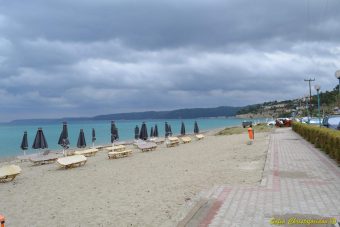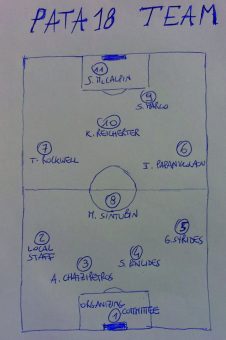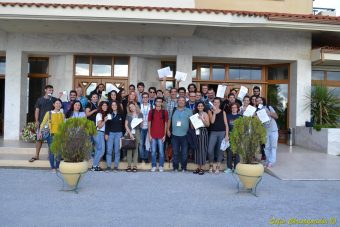On Thursday 28th June, I had the opportunity, together with over 40 students and Early Career Researchers, to attend the full-day summer school organized during the 9th PATA Days Congress in Possidi, Greece.
Gotha speakers gave short lectures on a variety of topics; well, it’s quite strange realizing that behind a book cover or a long list of papers you’ve read there’s a real person with a face, 2 hands and 2 eyes… but that’s what happened to me.
Location, location, location
As geoscientists, we all know the importance of a proper location… the Possidi Holiday Resort is just 20 m from the beach! Even the storm Hera did not prevent us to go for a swim.

The Possidi Beach. Photo by Sofia Christoforidou.
The summer school
- The first lecturer was Klaus Reicherter, dealing with tsunamis in the Mediterranean and in Greece and highlighting the inherently multidisciplinary nature of such a research.
- Tom Rockwell focused on strike-slip fault with worldwide examples – S. Andreas, North Anatolian, Great Sumatra and Dead Sea Faults – and field-based results.
- Jim McCalpin spoke about the use of paleoseismology in seismic hazard assessment, giving us a bucket of real-life examples, experiences, good (and less good) practices. And I learned that when building a logic tree, a 5% probability is not denied to (almost) everybody.
- Shmulik Marco showed on- and off-fault archaeoseismological evidences and soft-sediment deformations along the Dead Sea Fault. Plus (in my opinion) the best tip of the day: keep good relations with archaeologists, you never know what they will discover under the dirt.
- Then, Spyros Pavlides dealt with active faulting in multi-fractured seismic areas, and specifically the Aegean region. Just in case you are wondering if there’s something simple there, ehm… no, you should consider multiple tectonic phases, inherited structures, the presence of normal faulting, subduction zones and volcanic activity all together.
- We definitely changed perspective with Manuel Sintubin, speaking about earthquake risk communication and the need to move from a risk message model toward a risk dialogue model; this is a super-important topic not always addressed in the proper way, with possible huge consequences.
- Ioannis Papanikolaou spoke about the seismic landscape, extraction of slip rates and fault specific SHA with tens of examples from Greece and Italy and useful tips on advantages and disadvantages of each methodological approach.
- Finally, Georgios Syrides gave a lecture on sea level change indicators. Well, I’m very ignorant on this because simply it’s not my bag, so I learned lots of things (bonus: super-cool photos!).

Here’s the PATA team! (yes, I’m quite mad with football and the World Cup was ongoing…)
“He who knows only his own side of the case knows little of that” – John Stuart Mill, On Liberty, 1859
I saw top scientists jump on their seats when other top scientists called “small” a M 6 or “moderate” a M > 7 earthquake. Or when a trench revealing 5 events was called a “short record”. We all have different perspectives, opinions and experiences. And with “we” I mean all of us, from top scientists down to undergraduate students. I think it’s a richness and we should take care of it.
Final remarks: thanks!
The success of the summer school and the whole 9th PATA Days meeting would not have been possible without the contribution and efforts of the Thessaloniki University staff. A big thank to all of you and see you in the next PATA meeting!
Many more photos taken during PATA 2018 are at http://bit.ly/PATA18_photos

Group photo of the summer school participants. Photo by Sofia Christoforidou.


No Comments
No comments yet.